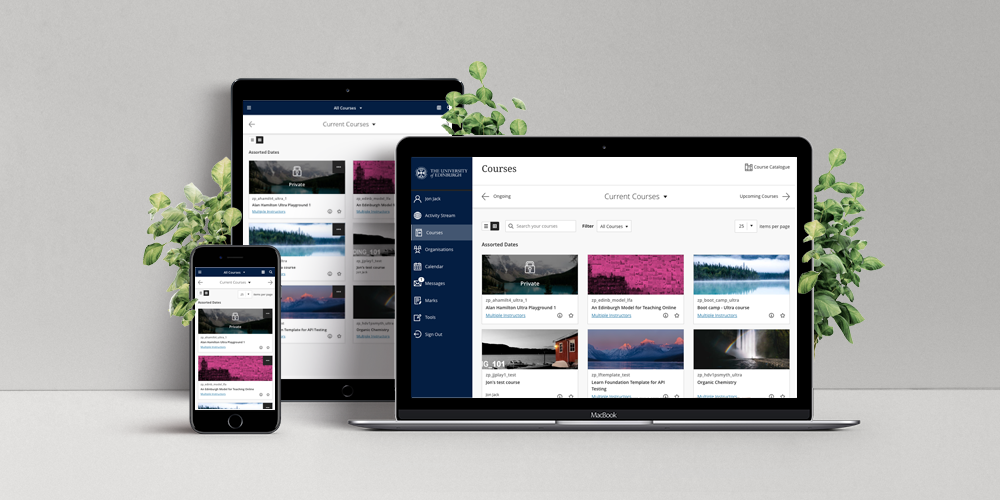
In this Spotlight on Learn Ultra post, Stuart Nicol explains the ‘quick wins’ that the first step in the upgrade of Learn Ultra, Learn Ultra Base Navigation, can offer colleagues from summer 2022. Stuart is the Head of the Educational Design and Engagement (EDE) section in Information Services Group.
The platforms we use for teaching are not passive, they invite us to do things in particular ways. In the ten or so years that we have had Learn as our core virtual learning environment (VLE) at The University of Edinburgh, the way it looks and functions has not changed very much at all. Increasingly, we’ve heard from students and staff that it looks a little dated; it is hard to disagree with that. The vendor (Blackboard) have been working on a new version for a few years now, and have spent time thinking about the way a VLE should look and function. Learn Ultra is the result, and it is has undergone a significant redesign. We have been quite cautious about this upgrade, choosing to let others be the trailblazers and test these new ways of working (Dundee, Durham, Aberdeen, Sheffield-Hallam, and a number of other universities in the UK have already made the change). As Melissa Highton introduced in the first blog post of this series, now is the right time to begin the VLE upgrade journey, not least to ensure we have a modern VLE to help deliver a transformed curriculum.
A useful feature of Learn Ultra is that it will allow us to make this journey in two distinct steps. We know that moving all of our courses into the new structures of Learn Ultra Course View will take careful planning, so we will be working with colleagues over the next year and a half to deliver this for the start of academic year 2023/24. However, we can make a significant improvement to Learn sooner without having to upgrade courses. This first step in the upgrade is called Learn Ultra Base Navigation (UBN), and it introduces some new ways of working and interacting with Learn. These are features that you will be able to take advantage of from summer 2022 whilst we work towards the bigger change for September 2023.
The main thing that you will notice in UBN is that the navigation metaphor has changed. Gone are the cluttered information blocks of My Learn; the tabs and the breadcrumbs, and the reloading of the page on every click. Now there is a persistent ‘base layer’ upon which courses and tools overlay. If you have ever worked with mapping software you might recognise the base layer concept: the key layer of information over which data and visualisations appear. The Ultra base layer is always there, and easy to get back to by simply clicking on the ‘X’ to close a layer. It also means that the browser doesn’t need to reload the page every time a course or a tool is opened, which should have a positive impact on the speed and efficiency of navigating between areas within Learn.
The base layer has an ever-present set of tools: Profile, Activity Stream, Courses, Calendar, Messages, Marks, and Tools. You can find out more about each of these on our UBN web page. These tools contain some new and interesting features, for example:
- Within the profile you can add your pronouns and clarify the pronunciation of your name through phonetic spelling and audio recording.
- The course page is much improved in comparison to the basic list view of My Learn. Users can filter courses by the various term types, search and favourite courses. It means we can remove the course list from MyEd, streamlining the route into Learn.
- Activity stream, Calendar and Marks are all new features, combining information from across all of a user’s courses into easy to find spaces.
- Activity Stream gives students a quick heads-up on all deadlines and important upcoming course events, with dynamic links to the courses in question.
- Calendar gives a combined view of important deadlines and dates from across all course calendars.
- Marks will enable teachers to see any marking required to be completed across all courses, and gives students a quick overview across all of their marks.
I think the design decisions behind UBN invite us to engage and interact with teaching and learning in the online space in new and interesting ways. For example, students can quickly engage with important information at programme rather than course level, something that often comes up in curriculum design conversations. Technically, the VLE also performs differently: by removing the need to reload pages at every click, and organising key information at the point of entry, there is the potential to make it quicker to access courses and get to the important things we need engage with.
So, with one eye on the longer path towards the main upgrade in September 2023, we can take advantage of some quicker wins in the new features that UBN delivers sooner. We can also begin to orientate ourselves to the new look and feel of Learn Ultra. Watch out for more information about UBN as we get closer to step one of the upgrade journey in July 2022.
 Stuart Nicol
Stuart Nicol
Stuart is the Head of the Educational Design and Engagement (EDE) section in Information Services Group. EDE are responsible for delivering a number of services to the University, including: advice, consultancy, and training for learning technologies; Learning Design (ELDeR); support for online learning, including MOOCs; and support for open education resources. Stuart joined The University of Edinburgh in 2007, initially in the School of History, Classics, and Archaeology, moving to what is now EDE in 2011. He has a master’s degree in Digital Education from The University of Edinburgh, and continues to have an interest in critical approaches to open education and practice.

